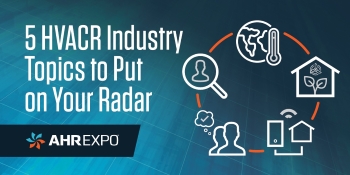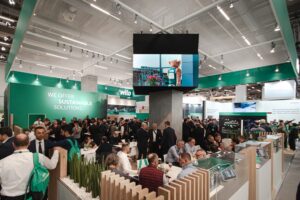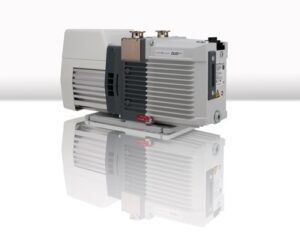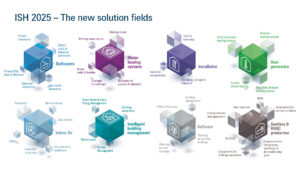AHR Expo Expert Council: 5 HVACR Industry Topics to Put on Radar

AHR Expo Expert Council (Image source: International Exposition Co.)
he HVACR industry has always been versatile with ever-evolving practices, upgrades, disruptive products and technologies. Though shifts may often seem slow progressing to the general population, the industry is currently primed to utilize and contribute to big tech trends and, more importantly, is gearing up to be on the center stage of global change.
In fact, HVACR has the potential to play a large role in the future of every person on the planet — a notion that is gaining greater realization by industry professionals. Despite this outlook, the challenge ahead remains — crafting an environment for humans to thrive and maximize their potential while keeping negative environmental impacts to a minimum.
To achieve these goals, cross-role communication among industry personnel is essential. In an effort to support the open flow of communication and stimulate ideation, the AHR Expo has gathered a council of industry experts aimed at discussing some of the biggest trends, issues and opportunities that lie ahead for HVACR.
Recently the Council convened to discuss and develop consensus views on five areas that are poised to be hot topics for the industry and at the upcoming 2020 AHR Expo in Orlando. The goal is to spark conversation and knowledge sharing among industry peers through articles, papers, online networks and on social channels.
Global Climate Change
Global climate change is not a new discussion topic, however, the inclusion of HVACR systems and their potential to support the lowest emission output possible is becoming more mainstream. Moving beyond the political landscape, long-term sustainability goals and embodied carbon are heavily considered in the design, integration, and installation of whole building systems.
Engineers are challenged with designing systems that meet or exceed performance expectations while staying on course with changing regulation. Contractors are faced with new regulations and must adapt to methods for installation and maintenance. On the global scale, net-zero initiatives are driving design and furthering the consideration of the entire HVACR system and its importance to the building function, as well as the necessary energy to support it.
New recommendations for climate change limits suggest a global temperature lower than 1.5C according to the Intergovernmental Panel on Climate Change (IPCC), a finding that has been referenced in climate change policies and initiatives across the globe.
“Minimizing climate change to the 1.5C limit by 2050 will require swift and unprecedented changes in the HVACR industry. There are great challenges and opportunities to be taken seriously if we want to arrive at net zero emissions in operating, embodied, and transportation carbon, yet maintain the superb wellbeing of building occupants,” says Luke Leung, director of sustainable energy at Skidmore Owings & Merrill LLP.
This idea of implementing new protocols to lessen emissions is not a task to be viewed lightly, particularly in societies where buildings and HVACR systems are already established. Cities around the world are taking serious measures to meet net zero goals. As reported by Forbes earlier this year as part of the Climate Mobilization Act, buildings totaling 25,000 square feet or more will face requirements to upgrade boilers. Additionally, starting in the year 2024, New York City building owners who do not comply with energy efficiency requirements will face fines made up of the difference in emissions limits for the year and a building’s actual emissions, multiplied by $268.
Some areas of consideration for HVACR professionals include:
Embodied Carbon Considerations
- Government regulations are a driving force for designers and builders to consider the full cycle of embodied carbon and a building’s carbon footprint. California’s government adopted the Buy Clean Act in October of 2017 and amended it in June of 2018. According to USGBC’s Los Angeles chapter, the legislation promotes the spending of taxpayer money in ways that help to reduce pollution contributors to climate change. Additionally, manufacturers and plants are held to tougher pollution standards and the emissions performance of suppliers and contractors is considered prior to project sign-on.
- Environmental Product Declarations (EPDs) are becoming commonplace in many countries around the world, with the expectation of further growth in the coming years. Currently, EPDs use the common methodology outlined in ISO 14024 to define and compare products. There are several supporting organizations in North America, including NSF International, the Sustainability Consortium, Carbon Leadership Forum, SGS Global Services, among others. LEED Version 4 also began to address EPD of products.
Low GWP Refrigerants
- While low GWP refrigerants are already in use across the industry, some options introduce safety hazards through fire and combustion risks and may require significant modifications to vapor compression equipment. According to a 2016 Lawrence Berkeley National Laboratory study, an estimated 700 million air conditioning systems will be in use by 2030. Not surprisingly, the quest to develop the next generation of refrigerants is already underway and is a buzzing topic of conversation among industry professionals. There is also debate as to which refrigerants will provide the most viable solution to the global climate challenge. The use of low GWP refrigerants remains heavily considered within the industry as a way to lower overall emissions.
Electrification
- The push to connect everything to the electrical grid in the future is a political hot button that is discussed across nearly every market. HVACR systems have been given a front seat in this debate for their potential to greatly reduce greenhouse gas emissions. In the U.S., buildings still primarily rely on natural gas, coal, or fuel oil as an energy source. The electrification discussion stakes claim that HVACR systems can be quickly decarbonized by removing old systems and upgrading to clean energy systems with electric heat or heat pumps. While the interaction between the electrical grid and buildings is changing, the idea of total transition has obstacles given the millions of homes and businesses currently relying on fuels for operation.
“Heat pumps, specifically ccA2WHP cold climate air to water heat pumps, are gaining attention from customers looking to cut ties with both gas and oil. Support of this method stems from the ability to integrate with PV generated at the building location to lessen grid loss, as well as the ability to generate heating, cooling and domestic hot water (DHW) from a single unit,” said Bob Rohr, a training manager with Caleffi North America. “Looking into systems like this and others that reduce negative climate impact is an added benefit for HVACR professionals because it introduces an increased role of hydronics and other technology avenues to the HVAC industry.”
While many technologies are being considered, the overall goal to move beyond reliance on products and applications that have a negative impact on the environment is shared. In the coming years, we can expect to see much progress in this area driven by government regulation, consumer demand and industry innovation.
Indoor Climate Controlled Growth Facilities
Indoor growth facilities are seeing an increase in interest for a few reasons. The first is the practicality behind their use in supporting rapid population growth. With progress made in HVACR and systems capable of cooling and heating extreme external environments, we are now living in areas of the world previously thought uninhabitable. This has pushed the boundaries of human living areas and expanded the built environment with fewer limitations.
Additionally, as the human population rises, so does the need for sustainable food options. Perhaps one of the biggest barriers to food production in relation to population growth is the loss of land space to nurture crops large in number and size. The process of indoor farming is already in practice in some areas around the world. For example, in 2014, Japan s Mirai Co. partnered with GE Japan to convert a former Sony factory into an indoor growth facility to house garden beds in what they’ve deemed a “plant factory.” The concept gained attention as it solves many of the controversial issues associated with traditional farming—the use of pesticides to control pests and bacteria and to ensure the health of the crop, and devastating crop loss caused by harsh weather, pollution, and other factors.
New markets are also taking on the challenge of investing in indoor growth facilities. The hemp and cannabis industry is a huge flagship for indoor growth and is becoming more commonplace across the U.S. Producers are looking for input and expertise to build an entire industry from the ground up.
“With more and more U.S. states allowing for the decriminalized use of marijuana and the widespread use of CBD products, there is a sudden increased demand for production. As a result, indoor grow facilities for cannabis is one of the fastest-growing verticals we’ve ever seen,” says Pam Duffy, Spark One Solutions, LLC and P.E. licensed engineer serving the HVACR industry for more than 10 years. “Many building owners are taking big capital risks to build these facilities, and producing high-quality products requires a precise approach to climate and lighting control. Currently, there’s a limited number of organizations in our industry that specialize or even have experience in this area. The prediction is that those who are willing to dive head-first into this market will be rewarded for many years to come.”
Indoor climates require precise control of a built environment, something the HVACR industry masters more than any. The opportunity to lead the design and production of an indoor growth environment, as well as the new jobs technicians, builders, contractors, manufacturers, suppliers and all those touching the industry will take on, makes this a viable opportunity for the industry as a whole.
Building Automation & Control
The area of Building Automation & Control (BAC) is quick paced and always changing. It maintains a prominent presence at the AHR Expo, and each year showcases new technologies and products that push boundaries. Where technology will take us is yet to be seen, and therefore makes this a buzzworthy topic for the foreseeable future. What’s more, the BAC discussion is expanding to include the Industrial Internet of Things (IIoT) and Industry 4.0, artificial intelligence (AI) and security.
The HVACR industry isn’t unique in tapping the IoT for deepened communication and information sharing. However, it provides unique and exciting opportunities because it allows for the open flow of communication between humans and the built environment. The IoT not only gives a closer connection between the occupant and the systems control but also enhances the service response time due to faster diagnostics and technician reporting. Already the IoT is streamlining the customer relationship—but where else can it lead HVACR?
Artificial intelligence in the HVACR industry has piqued interest in the idea of self-diagnosing buildings, where a broken system pinpoints a specific area of issue and auto-orders replacement equipment. This idea is provoking as it raises the question of the reliance on building system diagnostic accuracy, as well as the role of HVACR professionals in the future.
There are, however, concerns associated with increased connection and network sharing. Cybersecurity is an area of potential threat introduced with BAC and multiple building systems. This is new territory for most in the HVACR industry. As seen in areas using cloud-based and multiple networked systems technologies sharing communication, the opportunity for hackers is real and needs to be considered by all. This means building design and construction teams need to communicate potential risks and best practices associated with network use, and building owners need to be diligent in protecting their networks and secure information.
“The key is to make the building aware of what it needs to be aware of while maintaining local control. The security risks involved in taking data out of buildings completely, sending it all over the world, is far too great. What we see more of is a higher focus on security issues with the underlying idea of having control at the edge, closer to the data source.” says Nicolas Waern, The Building Whisperer.
Changing Consumer Demand
Consumer demand speaks to all the above-mentioned topics as the driving force behind innovation and change. The recognition that the largest population of building occupants is the incoming millennial generation, and that this cohort will also be the next generation of building owners brings to light a number of considerations that may not have mattered in the same way to previous generations.
Millennials perhaps more than any generation prior are active in the quest for sustainable options. They’ve been dubbed “generation green,” with 66 percent even stating they are willing to pay more for products and services that come from companies with commitments to positive environmental impacts, according to a Nielsen global survey.
Now more than ever, consumers are demanding control of environments in which they occupy. Dwellers are aware of and seeking control of their health in relation to outdoor and indoor environmental exposure. This includes the demand for clean air, the ability to closely control and monitor the indoor environment, and the opportunity to live within smart buildings that conserve energy based on many variables including occupancy and usage patterns.
Smart home control systems have skyrocketed in recent years, adding an attractive real estate feature to homes with updated HVACR and lighting systems. Consumers are also conscientious to the fact that we spend nearly 90% of our time indoors, as indicated in an EPA sponsored survey of national human activity, and the indoor environment and its potential exposures can influence personal health.
This shift of attention toward interior environments quality means the HVACR design and system selection has the potential to be influenced by different priorities than those currently in use today. Occupant desire for greater control coupled with their purchasing of buildings and leasing of spaces reflect this priority and indicate it will change the manner HVACR is done.
Business owners will likely also demand better indoor environments as it has been shown to impact employee productivity and wellbeing. It can also be anticipated that there will be increased legal exposure to building owners to provide safe and clean air as occupants become more knowledgeable, technologies capable of measuring and monitoring space quality become less expensive, and data becomes more readily available. Restaurants, merchants, theaters, etc. may also take advantage of this new focus through marketing clean air to distinguish themselves from the competition— much like the food grade systems we see in place in cities across the world.
Overall, a more health-conscious group of individuals is aging into building ownership with funding to spend on improving the interior space they occupy. HVACR professionals can benefit from the opportunities to cater to this new audience and their set of priorities. Manufacturers are also keen to this shift and are responding with products and technologies that excel in innovation to meet the charge.
Job Force Recruitment
The trend that perhaps stands to be the greatest obstacle for the HVACR industry in the immediate future is the need to replenish an aging job force. Due to a reduced interest in skilled trades as a career path and the economic recession in the early 2000s that contributed to stagnation in hiring, the industry faces a lag of incoming professionals to meet the replacement demands of those aging out of the industry. What’s more, even if rising students are interested in pursuing engineering or a skilled trade, they may not choose the HVACR industry over others requiring similar applied skills. The industry needs to take notice of these challenges and work together to recruit a new generation of HVACR professionals. This is an industry where long-term careers can be built as the role of HVACR is and always will be vital to all areas of the world, in every building and in every home.
The workforce will also need to consider a broader demographic than represented today to fill the void in the workforce. Women, as well as ethnic minorities, should be considered as part of this solution. While there has been an indication of growth here, it is still possible in the year 2019 to be the first minority graduating from a trade school, as evidenced by Ryli Jetton, who recently became the first female graduate with an Associate’s degree in Heating, Ventilation and Air Conditioning from State Technical College of Missouri. The HVACR industry needs to do a better job of championing the many opportunities that exist in the HVACR business to attract individuals from all backgrounds. This will not only help fill the shortage of professionals but will also introduce a broader set of ideas and talents to the conversation, ultimately making the industry stronger.
“The way we promote the greatness of the HVACR industry to younger generations is through in-person interactions and open communication. We need to invite them into engineering firms, let them shadow mechanical contractors, visit job sites, attend events like the AHR Expo, ASHRAE events, and other industry association events. The opportunity to have real-life experiences in the field will make all the difference,” says Karine Leblanc, an engineer at US Air Conditioning Distributors. “Having been exposed to the industry at a younger age myself, I remember the experience of visiting an engineering office and having a project manager explain to me why the thermostat should not be at its location. I was only 15 at the time, but this one interaction shaped what has become my engineering career.”
All these topics and more will be discussed in forthcoming articles as well as at the 2020 AHR Expo, to be held in Orlando, Florida, February 3-5th.
Source: International Exposition Co.






